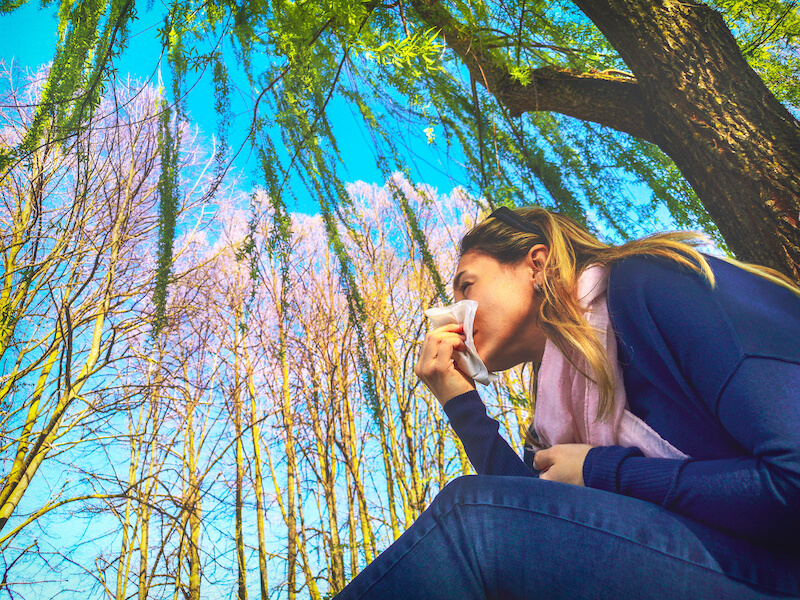
Spring is finally here! After a long cold winter, it’s terrific to finally open up those windows, take a breath of fresh air… and start to sneeze. Okay, the sneezing part isn’t so enjoyable. But the reality is, it’s allergy season.
In general, allergy season goes from March to October each year. Does that mean you’ll have nine months of itchy eyes and runny nose to look forward to? Well, maybe not. There are a couple of ways that you might be able to look forward to some relief this year.
What are seasonal allergies?
When we think about “allergy season,” it’s usually referring to, well, seasonal allergies. But let’s back up and understand what produces allergies in order to better understand what seasonal allergies are. Generally speaking, an allergic reaction happens when your body mistakes a harmless substance for something dangerous and triggers your immune system in an attempt to protect you.
This results in a variety of symptoms, though the most common are those “cold-like” symptoms we frequently associate with seasonal allergies: coughing, sneezing, runny nose, itchy eyes, and so on. Depending on the allergen, people might also experience swelling, trouble breathing, or more severe symptoms.
The human body, obviously, has no limit to what it may be allergic to. But being allergic to outside particles, like pollen and spores is very common. The term “seasonal allergies” relates to these pollens and spores that generally appear and cause symptoms on a seasonal basis (such as spring for example).
How to plan for the 2022 allergy season
So what does the 2022 allergy season have in store for you? The simplest way to create reasonable expectations might be to look at the year on a month-to-month basis.
April allergies
If you seem to be sneezing and coughing in April, the responsible party may actually be the trees outside your window. This may come as a surprise to some because most people don’t think of trees as especially offensive. But trees are pollinating plants, as well!
Different kinds of trees will pollinate during different months, so if you find the first few weeks of spring particularly difficult, it’s because you may be allergic to Ash trees or Maple trees, and that determines when you start sneezing. Typically, the best way to control your symptoms during this time is to monitor the daily pollen count (usually you can find this on any weather app or the local news) and stay indoors when the count gets too high.
Allergies in May and June
May and June produce the next group of pollinating plants. Grasses and flowers are usually the sources of these pollens. These pollens are widespread and potent, mainly because of the quantity of rain that falls in April, May and June. You will probably have prolonged symptoms in May and June if you are allergic to any of these flowering plants or grasses.
Try to get any outside work accomplished in the morning or evening as these pollen counts have a tendency to reach a peak in the early afternoon.
In July, you might get some respite
It’s dryer in July generally speaking. So your allergies could take a rest for a while. This will, obviously, depend on local weather patterns during any given year. So if you have to organize that outdoor family gathering, July will probably be the best time to do it!
August through October allergies
Don’t get used to the allergy threshold in July though. That’s because August brings in the beginning of ragweed season. The allergy symptoms from ragweed, also known as “hay fever” are very common.
And what’s worse, ragweed hangs around a while. You could be dealing with this specific allergen all the way through to October. Naturally, ragweed isn’t the only allergen that sticks around until the ground freezes. During this time of the year mold spores are also quite active.
Combating seasonal allergies
Managing your seasonal allergies can be challenging. You can attempt to figure out what allergens are activating your symptoms by noting when they appear. But you might have to call us for a consultation to really determine the cause of your allergies.
Still, you can decide how to structure your year by learning what time of the year certain allergies peak. That’s relevant for the 2022 allergy season and it will still be relevant for the 2023 allergy season. Stay tuned to your local weather patterns because there will be small fluctuations from year to year (it seems like the allergy season is getting more extreme and longer all of the time).
You can still appreciate being outdoors even if you have seasonal allergies. But an antihistamine and a bit of planning will go a long way.
References
https://www.mayoclinic.org/diseases-conditions/allergies/symptoms-causes/syc-20351497#:~:text=Common%20allergy%20triggers%20include%3A,from%20a%20bee%20or%20wasp